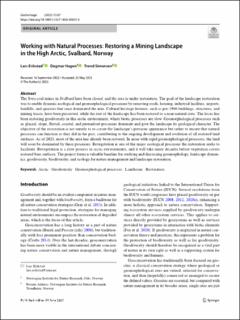Working with Natural Processes: Restoring a Mining Landscape in the High Arctic, Svalbard, Norway
Peer reviewed, Journal article
Published version

View/
Date
2023Metadata
Show full item recordCollections
- Publikasjoner fra CRIStin - NINA [2364]
- Scientific publications [1392]
Original version
10.1007/s12371-023-00855-4Abstract
The Svea coal mines in Svalbard have been closed, and the area is under restoration. The goal of the landscape restoration was to enable dynamic ecological and geomorphological processes by removing roads, housing, industrial facilities, airports, landflls, and quarries that once dominated the area. Cultural heritage features, such as pre-1946 buildings, structures, and mining traces, have been preserved, while the rest of the landscape has been restored to a near-natural state. The focus has been restoring geodiversity in this arctic environment, where biotic processes are slow. Geomorphological processes such as glacial, slope, fuvial, coastal, and permafrost processes dominate and give the landscape its geological character. The objective of the restoration is not merely to re-create the landscape’s previous appearance but rather to ensure that natural processes can function as they did in the past, contributing to the ongoing development and evolution of all restored land surfaces. As of 2023, most of the area has already been restored. In areas with rapid geomorphological processes, the land will soon be dominated by these processes. Revegetation is one of the major ecological processes the restoration seeks to
facilitate. Revegetation is a slow process in arctic environments, and it will take many decades before vegetation covers restored bare surfaces. The project forms a valuable baseline for studying and discussing geomorphology, landscape dynamics, geodiversity, biodiversity, and ecology for nature management and landscape restoration.
